How Women Is Treated at Work Peer Review Articles
Abstruse
Awareness of gender equally a fundamental feature in all aspects of everyday life and society has become more than and more widespread. The dynamic and constantly evolving nature of the social sciences reflects the increasing concern for gender studies. This article provides a review of some of the recent literature (published in specialist journals) on gender in direction and organizations to examine contributions from academics associated with different research areas. A total of 723 articles are examined from two key journals (Gender, Work & Organization [GWO] and Gender in Management [GIM]) to outline leading issues and themes in recent research over the period 2005–2015. While we identify several similarities between the 2 journals, 'Corporate Governance' is the topic that seems to capture most attention in GIM, while GWO's coverage is more focused on 'Discrimination' in the workplace, 'Differences between men and women' and 'Conflicts of interest'. This paper contributes to the literature in two means. First, it provides a focused assay of gender inquiry published over a 10-twelvemonth period. In addition, it outlines areas for hereafter research in the field of gender in management and organization (that is, gender quotas, new business opportunities for female entrepreneurs) and advocates for a more interdisciplinary research approach. This article is published as part of a drove on the role of women in management and the workplace.
Introduction
Research into gender in direction and organizations is constantly evolving. When a research field is dynamic information technology can be benign to step back and take stock of emerging themes and patterns to both critique the electric current state of research and inform futurity research agendas. By understanding the dominant issues, we can build and develop new cognition. Thus, the purpose of this article is to examine the evolving field of research in gender in management and organizations.
Initial research into gender in management and organizations stems from the 1970s, particularly by authors of Anglo American origin (Schrier, 1975). Previously the research field was neglected (De Carlo and Lyons, 1979) and the few existing studies were androcentric with theoretical reflection centred effectually the effigy of manager or entrepreneur conceived as neutral, but described on the basis of features and attributes that are typically male (Schwartz, 1976).
Early studies then adopted a predominantly male vision in both explaining organizational behaviour and in identifying the explanatory variables of the choices and behaviours of entrepreneurs when starting and managing a business. Therefore, the view of women in the business earth was oriented to the past. Women in direction and organizations were not perceived every bit a manifestation of a natural social evolution, in which the woman is no longer constrained by the boundaries of her function as mother, wife, and/or housewife, but rather as an exception, of interest because the ascendant interpretive model is masculine.
Withal, since the early 1980s at that place has been increased involvement in women managers and entrepreneurs, often from an interdisciplinary perspective, combining, for instance fields such as sociology, psychology, management, and organizational studies and economic science. This review seeks to evaluate the developing field of gender in management and organizations to identify dominant research topics and uncover those yet to exist explored. It reviews recent literature in the field from unlike perspectives: corporate governance; female entrepreneurship (Paoloni, 2011; Paoloni and Dumay, 2015); conflicts of interest; differences between men and women; discrimination; other. We examined 723 articles from two key specialist journals published between 2005 and 2015 (Gender, Piece of work & System [GWO] and Gender in Management [GIM]).
Adopting a structured literature review methodology (Massaro et al., 2016) nosotros asked the post-obit research questions:
-
RQ1. What is the focus of the gender literature?
-
RQ2. How is research on women in work and management developing in leading journals in the field?
In answering these questions this review contributes to the literature by analysing gender research published over the period 2005–2015, to proceeds a better agreement of the direction of contemporary women in work and management research. It highlights the emergence of women in corporate governance as a major surface area of research and draws attention to other key emerging research themes in the literature. It also identifies a growing focus on practical inquiry and signs of a narrowing of the gap between gender research and practise.
Methodology
This commodity uses a structured literature review (SLR) method equally proposed by Massaro et al. (2016). SLRs are becoming more commonplace as technology at present allows researchers to easily gather large volumes of articles relevant to a particular research field. Thus, a SLR allows researchers to apace analyse the attributes of a particular inquiry field and develop insightful research questions and directions that are likely to differ from those of a traditional authorship literature review. While the value of traditional reviews "lies in the fact that they are written by someone with a detailed and well-grounded noesis of the issue" (Petticrew and Roberts, 2008: x), a SLR follows a specific methodology that selects and evaluates contributions, analyses and synthesizes data, and finally it reports the research bear witness with transparency, comprehensiveness and reproducibility (Tranfield et al., 2003; Littell et al., 2008; Denyer and Tranfield, 2009). In this article, we accommodate Massaro et al.'s (2016) method as outlined in the post-obit sub-sections.
Selection of articles
Nosotros clarify the attributes of 723 articles on gender in direction and organization published between 2005 and 2015 from two primal journals: Gender Piece of work & Organization (GWO) and Gender in Management: An International Journal (GIM) as shown in Table 1. These are the leading journals in the field and we employ a ten-year fourth dimension menstruation because it is short plenty to ensure we are analyzing the most recent literature and long enough and so nosotros can uncover emerging enquiry trends.
GWO provides "a forum for papers that become beyond a traditional oppositional-binary concept of gender", publishing international theoretical, epistemological and methodological papers that appoint with sociological and/or gender theory. Information technology invites contributions from all disciplinary perspectives, including anthropology, history, labour economics, police, philosophy, politics, psychology and sociology. Mutual keywords of these studies are: piece of work, organization, industrial relations, anthropology, history, labour economics, constabulary, philosophy, politics, psychology, sociology, management, recruitment, career, development, journal, analysis, research, periodical, commodity, employment and police force (run across http://onlinelibrary.wiley.com/journal/x.1111/%28ISSN%291468-0432).
GIM specifically addresses the theme of female entrepreneurship and direction. Information technology focuses upon empirical research, theoretical developments, practice and electric current international issues in the field. It publishes inquiry, conceptual and thought pieces from both researchers and practitioners inside the global gender in direction field (http://www.emeraldinsight.com/journal/gm).
Defining the belittling framework
The structured literature review is an iterative process in which the taxonomy of research themes and issues is developed and refined throughout the review and writing process. For this review, we commencement examined the framework developed past Guthrie et al. (2012: 71) so deleted, added and or changed categories and their attributes according to which were virtually applicable to the research questions. Where incertitude existed, we also consulted other academics for input. For example, we created the article type category named "other" to include all editorials, forewords, tributes, notes and comments. As we reviewed and classified articles and discovered new attributes we placed these into loose and emerging classifications. Thus, throughout the review process the classifications were refined and adapted. Table two presents the taxonomy of gimmicky inquiry categories and attributes that emerged from this process and make up the belittling framework.
We selected the final categories after reading the titles, abstracts and keywords of the articles. When we could not classify an article based on these attributes, i author searched and/or read the full article until it could be properly classified. Two authors worked together to spot-bank check classifications and coding for consistency. When there was ambiguity or uncertainty about a lawmaking, the authors discussed the coding until they agreed.
The purpose of the category "commodity focus" is to place the specific focus of manufactures in society to gain insights into which topics are of continuing interest to scholars or otherwise. They are outlined below.
-
A1 Corporate governance includes those articles most the presence of women on boards of directors, audit or other company committees. A1 also includes articles concerned with career paths, the glass ceiling phenomenon or the pinkish share. Footnote 1
-
A2 Female person entrepreneurship includes female person entrepreneurship more broadly and specifically, the family business, relational capital, the formal and informal networks that women entrepreneurs activated during the life cycle of their company, and dissimilar bug that women have to overcome in doing business.
-
A3 Conflicts of interest include manufactures most conflicts between piece of work and family, motherhood, piece of work–life balance, career cycle/life wheel, and age and career paths.
-
A4 Differences between men and women.
-
A5 Discrimination at work includes discrimination against women in the workplace, and in the political, economic and social fields.
-
A6 other collects all those manufactures that do non belong to other categories like niche research, the evolving situation of women, special problems, general review articles, the social situation of women in item regions (Arab, Japan, Islamic).
The category "inquiry surface area" is used to allocate articles based on the field to which they belong. Many articles were interdisciplinary in nature. Every bit many manufactures were from research centres, rather than university departments, we as well incorporated this information to accurately understand the dominant perspective taken. We established the following categories:
-
psychology;
-
political, sociology sciences;
-
communication, education, anthropology, human sciences, philosophy, geography;
-
engineering and technology;
-
business combined with other fields of research;
-
management (full general management, organization, marketing and and then on);
-
Not-academic (that is, centre studies);
-
biomedical ethics, health and social care;
-
arts and social, cultural, humanistic sciences:
-
other (editorials, generic manufactures and and so on).
In terms of geographical origin of the research, we classified the manufactures non based on the surface area of origin of the author, simply the location of the research (for instance, regardless of the writer's location, if an article analysed the careers of women in Japan, it was categorized every bit Asian). The following categories were established:
-
Comparative Report; Comparative study includes enquiry comparing unlike country contexts. The Britain is not included in Europe because in that location was a high number of UK-based studies, sufficient to form its own category.
-
Middle East (Emirates, Israel);
-
South America (Argentina, Dominican Republic);
-
Northward America (Canada, the United States);
-
Northern Europe (Austria, Belgium, Denmark, Switzerland, Netherland, Republic of ireland, Republic of finland, French republic, Netherland, Republic of ireland, Finland, French republic, Germany, Iceland, Norway, Sweden, Poland);
-
Southern Europe (Hellenic republic, Turkey, Kingdom of spain, Portugal, Italy);
-
Asia China Japan, Korea, Singapore, Sri Lanka);
-
Africa;
-
The Great britain;
-
Oceania.
The articles were as well categorized according to research method. The category "Other" includes those manufactures in special bug or critiquing other articles or responding to critiques.
We established the following methods, including whether the work is qualitative, quantitative or mixed.
-
literature assay;
-
qualitative enquiry;
-
quantitative research;
-
mixed methods inquiry (which includes both qualitative and quantitative methodology);
-
discussion, conceptual or critical article (no empirical data or specific assay of the literature);
-
other (editorials, generic article where the methodology is not specified, or critical articles).
Results
This section provides the descriptive results of the written report and offers a discussion virtually the results to answer research questions 1 and 2: How is research inquiring into gender developing? What is the focus of the gender literature? We do this past summarising the wide trends in gender research over the last 10 years past offering a comparison between the ii journals.
Article focus
For the periodical GIM, corporate governance is the chief focus of inquiry over the period (97 of 354 articles), followed by an analysis of differences betwixt men and women (77) and conflict of interests (63). (Figs. 1 and 2)
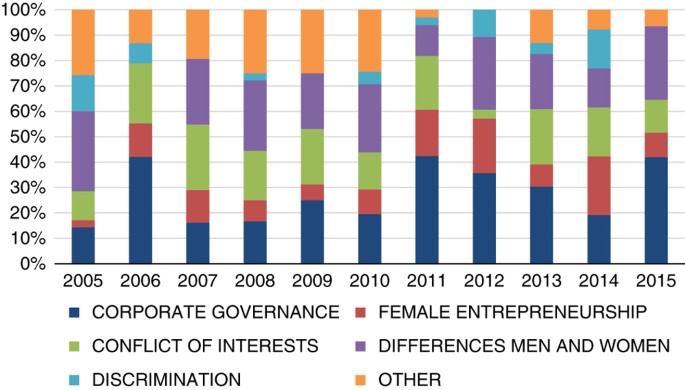
GIM—article focus
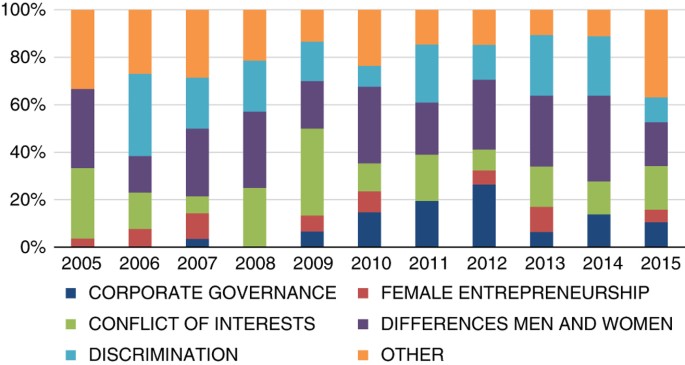
GWO—article focus
For GWO, consistent with its interdisciplinary approach, the main focus of researchers is: discrimination and differences between men and women are first with 100 of 369 articles, followed by other (76) and conflicts of interest (67).
Research area
For both journals, the main area of research of the authors is management. Hereafter inquiry could break down for deeper assay to establish more specificity (that is, accounting, marketing, finance) or theoretical frameworks the manufactures have adopted. For GIM the other 2 areas that dominate are psychology and political and social studies. (Figs. 3 and iv)
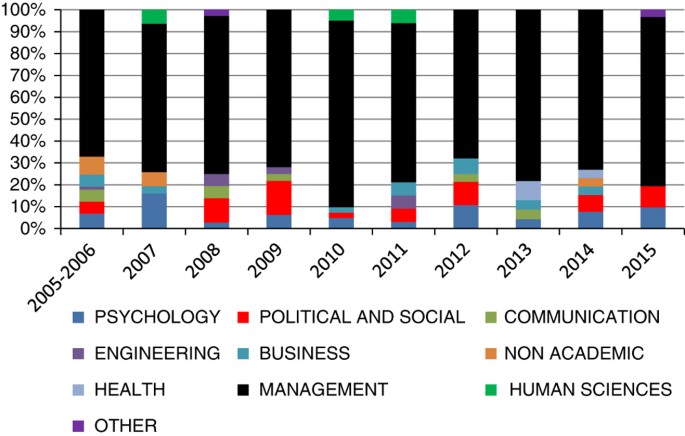
GIM—inquiry areas
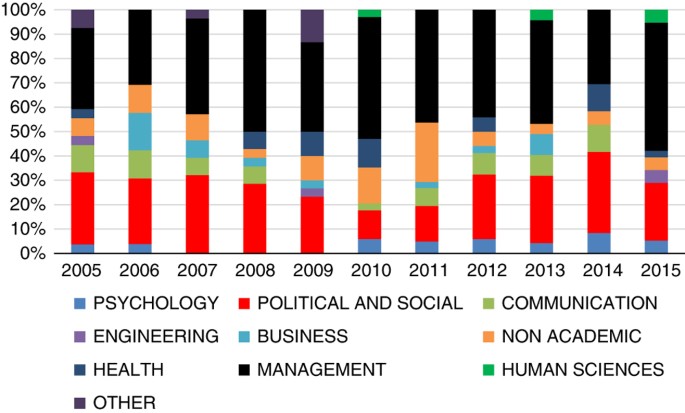
GWO—research areas
Geographical area
For both journals, the geographical focus of articles was the United Kingdom and Northward America. N Europe was the next most mutual location, with articles about women in Oceania, South Europe, Arab States and Asia less common and those focusing on Due south America and Africa very rare. This is not surprising because there is a long tradition of gender studies in the Uk and North America. Notwithstanding, it may be interesting to understand why in other countries such as Southward Europe and Asia there has been less interest. 1 possible caption is the language barrier, with mayhap more literature in the native languages of these locations. (Figs. five and 6)
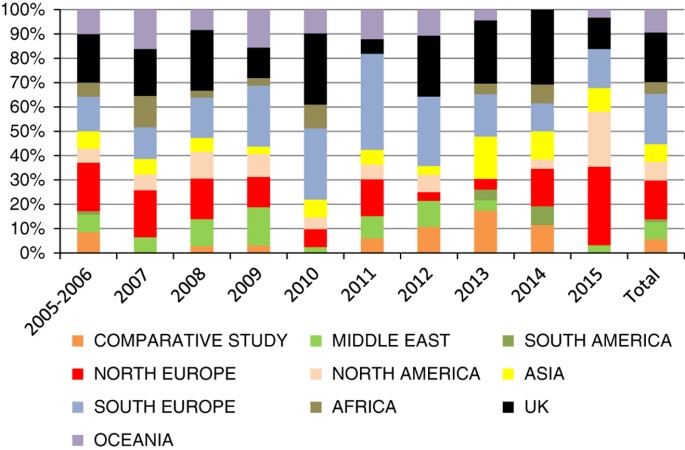
GIM—geographical areas
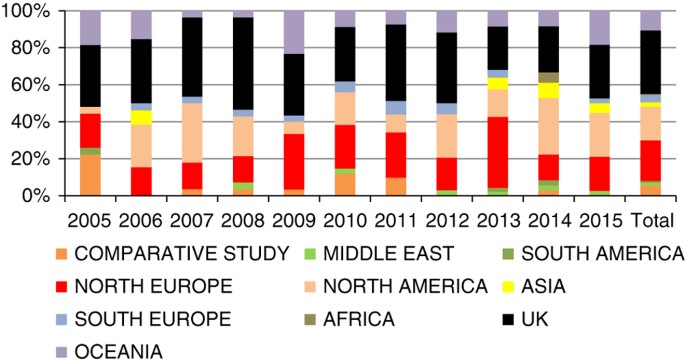
GWO—geographical areas
Research method
Almost half of the manufactures published in GIM journal adopt a qualitative research arroyo (176) but this trend has been decreasing over the last 5 years. Worth noting, is the number of articles (23) undertaking a literature review. Articles using a quantitative inquiry method take been besides published oft in the last decade (116 of 354). In GWO, near authors present qualitative articles (253 of 369). In both journals, a normative approach is not common (on boilerplate 10% of the total amount of articles) and mixed methods are seldom used. (Figs. seven and 8)
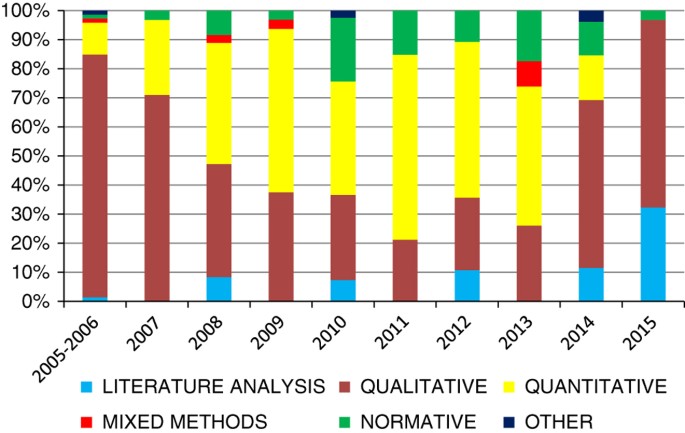
GIM—inquiry methods
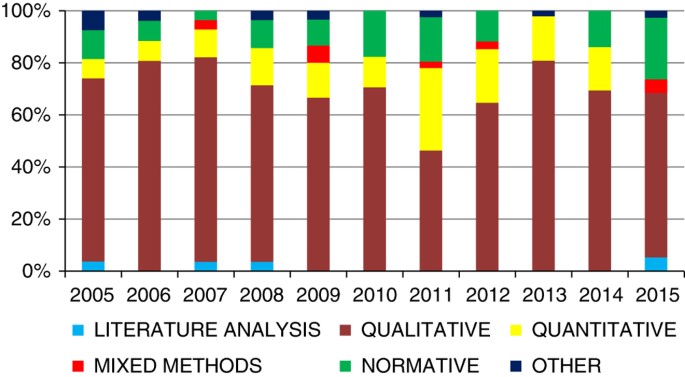
GWO—inquiry methods
A research calendar
This section provides the descriptive results of the study to answer RQ1. What is the focus of the gender literature? and RQ2. How is research on women in work and management developing in leading journals in the field?
Here a summary of the broad trends in gender enquiry over the terminal 10 years and a comparing betwixt the 2 periodical, is presented. To do this, nosotros examined whether and how in the by 10 years have inverse the origin of the article, the methodology used and the department of origin of the two journals.
The primary conclusions are the following:
In both journals, we find several similarities:
-
As far every bit focus is concerned, women and corporate governance is the topic that seems to capture more than attention.
-
Nearly authors belong to the Management field of research. It follows researchers involved in political and social scientific discipline disciplines
-
Most inquiry has been developed focusing on gender issues in Anglo-Saxons countries such every bit the United Kingdom and Northward America
-
The method most frequently used in both Journal is the qualitative 1. However, in GIM Journal, a remarkable number of articles (most 36%) evidence a quantitative arroyo.
Nosotros find that research on gender is multifaceted. Scholars involved in gender enquiry belong to many fields of research. Even inside each discipline, researchers accost the subject of gender through unlike lenses, applying a range of theoretical frameworks and methods. Consequently, nosotros run into that research on gender crosses the boundaries of different areas of study and we anticipate further interdisciplinary investigations and cross-fertilization.
The dominance of academics from an Anglo-American background, suggests a "Northern perspective", with few contributions from Southern Europe, South America and Africa. We run across that the future may contain more studies from these areas to shut this gap and every bit testify nosotros indicate to a research network on gender studies called "IPAZIA" in which we are involved, that brings together Italian and Mediterranean countries to promote investigation on women in work and management.
Given that nosotros are living in a time of tremendous modify (as regards applied science, economic system, culture and lodge), with rapid innovation, globalization, growth of economies and lengthening life expectancy we anticipate these interrelated phenomena, which impact on every aspect of life, increasingly to be the subject of gender studies. These impacts may also lead to uncertainties and contradictions that tin can in turn threaten and disrupt or bring opportunities and benefits. Future inquiry may seek to reconcile these contradictions. Globalization is combined with localism; diversity is seen as a driver for creating value in organizations; migrants' integration tin be considered a lever to regenerate the stagnant economies of the advanced countries; sustainability in the medium to long term is a main goal for businesses seeking to combine profitability with attention to the environment and social welfare. Gender research tin can provide a perspective on the intersection of these fields of enquiry as they relate to sex, social and cultural identity, economic science, lodge, institutions, and geopolitical contexts (Martin, 2006).
In more specific terms, given the relevance of corporate governance equally a research field (Grisoni and Beeby, 2007; Guillaume and Pochic, 2009; Healy et al. 2011; Tlaiss and Kauser, 2011), we wait to encounter farther exploration of this, in particular, in relation to quotas and their impact on corporate performance and on the emotions and perceptions of men.
In the field of female person entrepreneurship (Jamali, 2009; Kirkwood, 2009), manufactures with a higher number of references have examined item geographical contexts, industrial sectors, or different psychological features that distinguish women from men entrepreneurs (Tyler and Cohen; 2008; Lewis and Simpson, 2010). Still, we found a lack of investigation as regard to new businesses opportunities in the sectors of the green economy, big data management and social media, which gives opportunities for future research. Another relevant topic, which nosotros expect to gain momentum, concerns women entrepreneurs and business network (Brunetto and Farr‐Wharton, 2007; Klyver and Terjesen, 2007; Singh and Belwal, 2008; Demartini and Paoloni, 2012).
The stream of research concerning differences between women and men includes studies addressing diversity and equality within varying socio-demographic backgrounds and geo-political contexts (Martin, 2006; Holvino, 2008), every bit well as in academic careers (Probert, 2005) and other professions (Powell et al. 2009). In the calorie-free of the new challenges of the fourth industrial revolution (Schwab, 2016), nosotros suggest that more research is needed in this field to span the gender gap in science, engineering science, technology and mathematics (Friedman, 1989). This research could exist successful to promote scientific and technical training for girls and raise the debate on new digital skills needed to enter the world of piece of work (Cooper, 2006).
Nigh research of conflict of interests concerns balancing time betwixt work and family (McDonald et al., 2005; Smithson and Stokoe, 2005; Forest and Newton, 2006; Ezzedeen and Ritchey, 2009). Other authors focus more than on discrimination confronting women in the workplace and in other political, economic and social contexts (for example, Eriksson-Zetterquist and Styhre, 2008; Bird, 2011; Nentwich and Kelan, 2014).
For future research in these two fields, we deem that in order to suggest possible and applicative solutions to bridge the gender gap, an interdisciplinary approach that combines management and organization, psychology, sociology, political economic and police, may be applicative.
Decision
This article contributes to the literature in several ways. Offset, it provides a focused analysis of gender enquiry published over ten years, allowing researchers to gain a better understanding of the direction of the contemporary gender enquiry field. 2nd, it draws attention to central emerging research themes in the literature. Finally, it suggests a growing focus on applied inquiry and signs of a narrowing of the gap between gender research and practice.
The hereafter research directions discussed higher up are about opening up new fields of inquiry, addressing neglected issues and consolidating the traditional fields of gender literature. We must challenge the status quo, employ innovative methodologies, provide empirical studies on gender, suggest applicable solutions to bridge the gender gap and help develop broader theoretical research.
Our conclusions should exist considered subsequently taking into account the following limitations. First, the choice of journals was restricted to two specialist journals. Results could vary if more journals were included and if other forms of scholarly activities were included (for case, monographs, briefing articles, books, book chapters, PhD theses and then on). Second, although the coding procedure was performed systematically, there could be errors of omission and coding every bit a result of coder bias. Third, the addition of "other" in classifications may have hidden some interesting findings.
Information availability
The datasets generated and analysed in this written report are not publicly bachelor but are bachelor from the corresponding author upon reasonable request.
Additional data
How to cite this article: Paoloni P and Demartini P (2016) Women in direction: perspectives on a decade of research (2005–2015). Palgrave Communications. two:16094 doi: 10.1057/palcomms.2016.94.
Notes
-
Pink share refers to rules aimed at protecting gender equality inside representative bodies.
References
-
Bird SR (2011) Unsettling Universities' Incongruous, Gendered Bureaucratic Structures: A Case-study Approach. Gender, Work & Organisation; 18 (2): 202–230.
-
Brunetto Y and Farr‐Wharton R (2007) The moderating role of trust in SME owner/managers' determination‐making about collaboration. Journal of Modest Business Management; 45 (three): 362–387.
-
Cooper J (2006) The digital split up: The special example of gender. Journal of Figurer Assisted Learning; 22 (five): 320–334.
-
De Carlo J and Lyons PR (1979) A comparison of selected personal characteristics of minority and non-minority female entrepreneurs. Journal of Business Direction; 1979 (1).
-
Demartini P and Paoloni P (2012) The relational capital in female SMEs. Journal of Academy of Business organisation and Economics; 12, 23–32.
-
Denyer D and Tranfield D (2009) Producing a systematic review. In Buchanan DA and Bryman A (eds). The Sage Handbook of Organizational Research Methods. Sage Publications: Thousand Oaks, CA, pp 671–689.
-
Eriksson-Zetterquist U and Styhre A (2008) Overcoming the glass barriers: Reflection and activeness in the "women to the superlative" programme. Gender, Work & Arrangement; 15 (2): 133–160.
-
Ezzedeen SR and Ritchey KG (2009) Career advancement and family balance strategies of executive women. Gender in Direction: An International Periodical; 24 (6): 388–411.
-
Friedman L (1989) Mathematics and the gender gap: A met-analysis of recent studies on sexual activity differences in mathematical tasks. Review of Educational enquiry; 59 (2): 185–213.
-
Guthrie J, Ricceri F and Dumay J (2012) Reflections and projections: A decade of intellectual capital accounting research. British Bookkeeping Review; 44 (2): 68–92.
-
Grisoni Fifty and Beeby M (2007) Leadership, gender and sense-making. Gender, Work and Organisation; fourteen (three): 191–209.
-
Guillaume C and Pochic South (2009) What would you lot sacrifice? Access to top direction and the piece of work-life balance. Gender, Work & Organization; 16 (1): 14–36.
-
Healy G, Bradley H and Forson C (2011) Intersectional sensibilities in analysing inequality regimes in public sector organizations. Gender, Piece of work & Arrangement; 18 (v): 467–487.
-
Holvino E (2008) Intersections: The Simultaneity of Race, Gender and Form in Arrangement Studies. Gender, Work & Organization; 17 (three): 248–277.
-
Jamali D (2009) Constraints and opportunities facing women entrepreneurs in developing countries. Gender in Direction: An International Periodical; 24 (4): 232–251.
-
Kirkwood J (2009) Motivational factors in a button‐pull theory of entrepreneurship. Gender in Direction: An International Periodical; 24 (five): 346–364.
-
Klyver K and Terjesen Southward (2007) Entrepreneurial network composition: An assay beyond venture evolution stage and gender. Women in Management Review; 22 (viii): 682–688.
-
Lewis P and Simpson R (2010) Meritocracy, difference and choice: Women's experiences of advantage and disadvantage at work. Gender in Management: An International Journal; 25 (3): 165–169.
-
Littell JH, Corcoran J and Pillai 5 (2008) Systematic Reviews and Meta-Analysis. Oxford University Press.
-
Martin PY (2006) Practising gender at piece of work: Further thoughts on reflexivity. Gender, Work & Arrangement; thirteen (iii): 254–276.
-
Massaro M, Dumay J and Guthrie J (2016) On the shoulders of giants: Undertaking a "Structured Literature Review". Accounting, Auditing & Accountability Journal; 29 (five).
-
McDonald P, Brownish G and Bradley L (2005) Explanations for the provision‐utilisation gap in work‐life policy. Women In Management Review; twenty (one): 37–55.
-
Nentwich JC and Kelan EK (2014) Towards a topology of "doing gender": An assay of empirical inquiry and its challenges. Gender, Work & Organization; 21 (2): 121–134.
-
Paoloni P (2011) La Dimensione Relazionale delle Imprese Femminili (trans. The Relational Dimension of Female Firm). Franco Angeli: Milan, Italy.
-
Paoloni P and Dumay J (2015) The relational capital of micro-enterprises run by women: the start-upwards phase. Gender in Management: An International Journal; fifteen (ii): 172–197.
-
Petticrew M and Roberts H (2008) Systematic Reviews in the Social Sciences: A Practical Guide. Wiley-Blackwell: Oxford, UK, p 354.
-
Powell A, Bagilhole B and Prissy A (2009) How women engineers do and undo gender: Consequences for gender equality. Gender, Work & Arrangement; 16 (4): 411–428.
-
Probert B (2005) "I merely couldn't fit it in": Gender and diff outcomes in academic careers. Gender, Piece of work & Organization; 12 (1): l–72.
-
Schrier JW (1975) The Female Entrepreneur. A Airplane pilot Written report. The middle for Venturing management.
-
Schwab G (2016) The Quaternary Industrial Revolution. World Economic Forum: Geneva, Switzerland.
-
Schwartz EB (1976) Entrepreneurship: A new female person borderland. Journal of Gimmicky business; winter: 47–76.
-
Singh Grand and Belwal R (2008) Entrepreneurship and SMEs in Ethiopia. Gender in Direction: An International Periodical; 23 (2): 120–136.
-
Smithson J and Stokoe EH (2005) Discourses of work–life balance: Negotiating "genderblind" terms in organizations. Gender, Work & Organization; 12 (2): 147–168.
-
Tlaiss H and Kauser S (2011) The bear upon of gender, family, and work on the career advancement of Lebanese women managers. Gender in Management: An International Journal; 26 (1): eight–36.
-
Tyler M and Cohen 50 (2008) Direction in/every bit comic relief: Queer theory and gender performativity in the office. Gender, Work & Arrangement; 15 (two): 113–132.
-
Tranfield D, Denyer D and Smart P (2003) Towards a methodology for developing evidence‐informed direction cognition by means of systematic review. British Journal of Management; 14 (3): 207–222.
-
Wood GJ and Newton J (2006) Childlessness and women managers: "Choice", context and discourses. Gender, Work and Organization; 13 (4): 338–358.
Author information
Affiliations
Ethics declarations
Competing interests
The Authors declare no competing financial interests.
Rights and permissions
This work is licensed under a Creative Commons Attribution four.0 International License. The images or other third party material in this article are included in the article's Creative Eatables license, unless indicated otherwise in the credit line; if the material is not included under the Artistic Eatables license, users volition need to obtain permission from the license holder to reproduce the material. To view a re-create of this license, visit http://creativecommons.org/licenses/by/four.0/
Reprints and Permissions
Most this article
Cite this commodity
Paoloni, P., Demartini, P. Women in management: perspectives on a decade of research (2005–2015). Palgrave Commun two, 16094 (2016). https://doi.org/x.1057/palcomms.2016.94
-
Received:
-
Accepted:
-
Published:
-
DOI : https://doi.org/ten.1057/palcomms.2016.94
mcclainthioseen37.blogspot.com
Source: https://www.nature.com/articles/palcomms201694
0 Response to "How Women Is Treated at Work Peer Review Articles"
Post a Comment